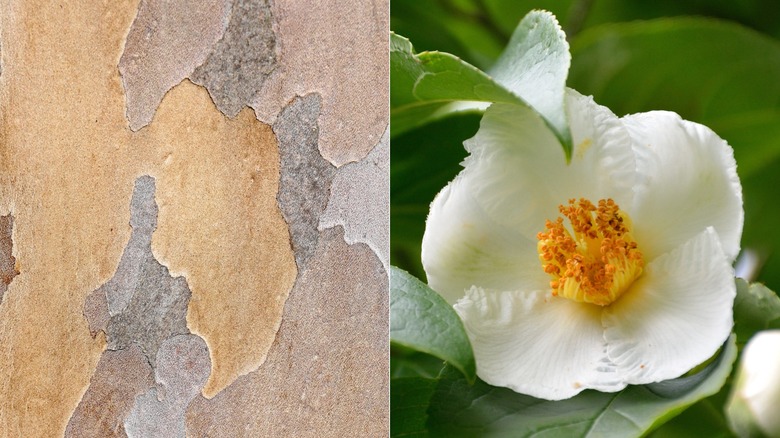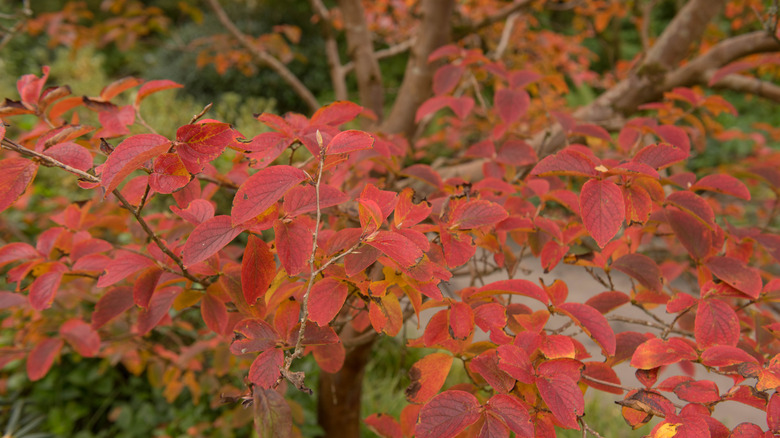The All-Season Tree Martha Stewart Recommends For All Of Its Benefits
Planning the perfect garden layout isn't something you typically get taught, so trying to design your outdoor space can often be a lot like feeling around in the dark. Without a well-rounded understanding of the types of trees and plants available to you, it's anyone's guess how they'll look once they're physically in your yard. Fortunately, the world has living legend Martha Stewart to help us improve our homes and gardens. When it comes to the perfect type of tree for bringing color and texture to your backyard, one that crucially differs from the usual options, the queen of all things home has spoken.
In a blog post on her official site, Stewart shared one of her all-time go-tos; a tree that makes a show-stopping addition to any garden. The Japanese stewartia (Stewartia pseudocamellia) instantly stands out from the rest, thanks to its flowers, leaves, and bark. Each part of the plant provides either a colorful display or an interesting texture throughout the year, so you'll never tire of seeing how it transforms season to season. Plus, it's got Stewart's seal of approval.
The Japanese stewartia tree boasts unique flowers, bark, and leaves
Martha Stewart knows a thing or two about gardening — she has her list of essential gardening tools down to a T and recently ditched her traditional method of vegetable gardening for a better, smarter alternative. It's no surprise, then, that the homemaking icon has some thoughts about curating the right trees for your garden. In her blog post, Stewart notes that the Japanese stewartia "is a small, slow-growing, all-season performer that shows off fresh green leaves in spring, white flowers resembling single camellias in summer, and colorful foliage in autumn." This year-round display makes it the ideal centerpiece for your own backyard.
The flowers most commonly feature frilly white petals and bright yellow centers, but there are other varieties available, including "Pink Form" and "Mint Frills," which produce eye-catching pink and light green blooms respectively. The tree's vibrant green spring and summer leaves turn to an electric red when fall rolls around, maintaining their visual appeal as the weather cools down. Speaking of which, even in winter when most trees are bare, it's a lovely plant to view for other reasons. The buds and branches make a pleasant shape, but the bark is the true gem. It's made up of various layers, creating a collage of different textures and colors.
Japanese stewartia trees are great for small gardens and have low disease risk
The explosion of color and texture that a Japanese stewartia tree offers is truly why they're such a spectacular choice when you're planning out your garden. But their relatively easy care requirements, size, and low susceptibility to diseases and pests are the icing on the cake. Gardeners with some experience under their belts will have no trouble taking care of these trees. They require a little more attention in the beginning, usually needing some kind of shelter during the winter months to avoid damage from wind.
They're pretty compact trees and grow slowly, so you won't have to worry about a garden being taken over by an overbearing tree. Not only are these trees perfect for a small garden, but they're happy in full sun or partial shade, too. While they prefer rich, loamy soils, these plants are much hardier than that. Poor quality soil and a lack of water won't lead to their demise. Additionally, there are no known pests or diseases that frequently riddle Japanese stewartia, so you can trust that with the right care, they'll flourish.


